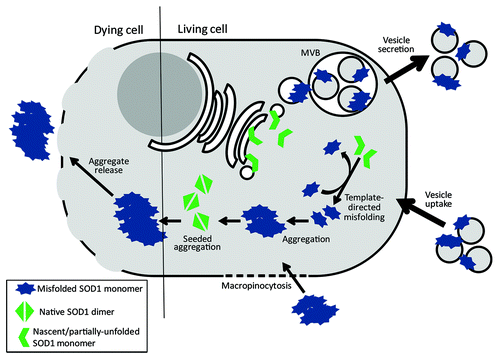Figures & data
Figure 1. Intermolecular conversion and intercellular transmission of misfolded SOD1. Intermolecular conversion of wild-type SOD1 likely occurs via two possible mechanisms. Nascently-translated SOD1 that is presumably still partially unfolded are substrates for template-directed conversion by pathological forms of SOD1. Conversion of nascent SOD1 to a misfolded isoform provides template for further rounds of native SOD1 conversion. Additionally, homodimeric wild-type SOD1 (or soluble forms of misfolded SOD1) can be misfolded and incorporated into pre-existing insoluble aggregates of misfolded SOD1 to form larger complexes. Intercellular transmission of misfolded SOD1 isoforms also occurs via two possible mechanisms. Soluble forms of misfolded SOD1 (likely monomer and small oligomers) are packaged via the endocytic pathway into multivesicular bodies (MVBs); MVBs fuse with the plasma membrane thus releasing vesicles, such as exosomes, to the extracellular environment. Furthermore, exosomes, with misfolded SOD1 presented on the outer surface, are subsequently taken by neighboring cells. This process likely occurs between living cells in early stages of ALS. Conversely, SOD1 aggregate release likely occurs during neuronal cell death as plasma membrane integrity diminishes. Uptake of SOD1 aggregates occurs via macropinocytosis; however it remains unknown if this process is non-specific or is regulated by cell-surface receptors.

